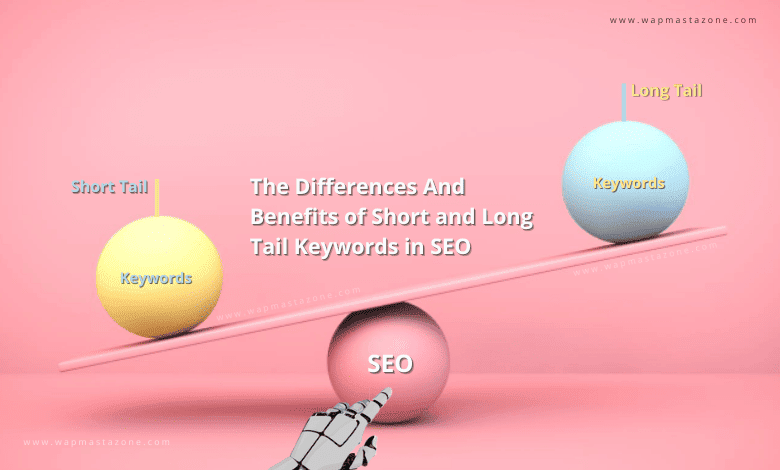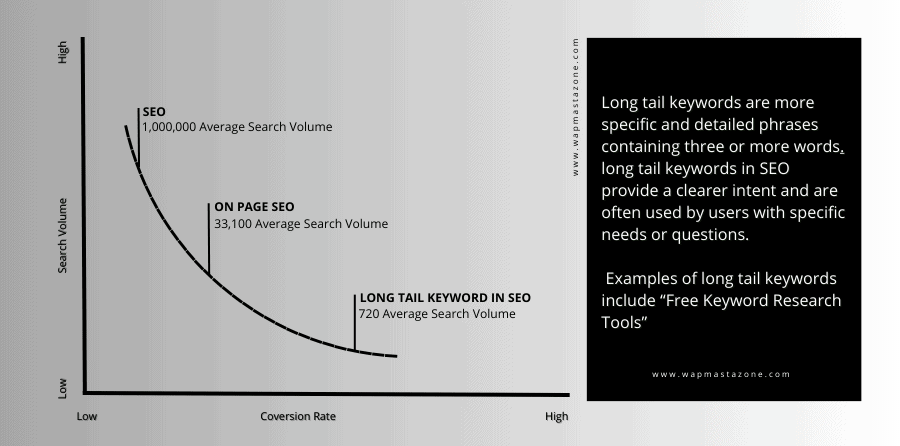Differences And Benefits of Short and Long Tail Keywords in SEO
long tail keywords in seo, short tail keywords in seo

Short and long tail keywords in seo – Keywords are important for a successful SEO strategies. They act as the foundation for optimizing web pages and improving organic search rankings. There two common types in keyword research, thy are short tail and long tail keywords. Understanding the differences between these two types and how to use them effectively can give you a competitive edge in the world of SEO.
Also read: SEO for Beginners – Ultimate Guide
Also read: RoadMap to Becoming An SEO Expert
What Are Short Tail Keywords?
Short tail keywords, also known as head keywords, are typically one or two words in length. These keywords are broad and generic, targeting a large audience. For example, “SEO” or “SEO Expert” are considered short tail keywords. Due to their broad nature, short tail keywords often have high search volumes and intense competition. It can be challenging to rank for these keywords, especially if you’re just starting or competing against well-established websites.
What Are Long Tail Keywords?
Long tail keywords are more specific and detailed phrases containing three or more words. long tail keywords in SEO provide a clearer intent and are often used by users with specific needs or questions. Examples of long tail keywords include “Free Keyword Research Tools” or “Best Web Hosting For Small Businesses.” Long tail keywords have lower search volumes compared to short tail keywords, but they also face less competition. This presents a great opportunity to target niche audiences and improve your chances of ranking higher in search engine results pages (SERPs).

Also read: What is SEO?
Also read: The Concept of ON Page SEO – Ultimate Guide
Also read: The Concept of OFF Page SEO – Ultimate Guide
The Differences and Benefits of Short and Long Tail Keywords in SEO
| Aspect | Short Tail Keywords | Long Tail Keywords |
| Length | 1-2 words | 3 or more words |
| Specificity | Broad, general | Specific, detailed |
| Search Volume | High | Low to moderate |
| Competition | Intense | Less competitive |
| User Intent | Often informational | Often transactional |
| Conversion Rate | Lower | Higher |
| Targeted Audience | Broader | Niche |
| Ranking Difficulty | Challenging | Easier to rank |
| SEO Strategy Focus | Brand exposure | Targeted traffic |
| Example | “SEO“ | “Top Tech Companies to Work For“ |
Below are benefits of and how to use Short and long tail keywords in SEO effectively.
Benefits of Short Tail Keywords:
1. High search volume: Short tail keywords often have a larger search volume, which means there is a higher potential for attracting traffic to your website.
2. Brand exposure: Targeting popular short tail keywords can increase brand visibility and awareness, as they are often associated with broader topics.
3. Broad audience reach: Short tail keywords allow you to cast a wide net and reach a broader audience. However, keep in mind that the audience may not always be as targeted or qualified.
Benefits of Long Tail Keywords:
1. Less competition: Long tail keywords have lower competition levels, making it easier for your website to rank higher in SERPs. This is particularly advantageous for new or niche websites.
2. Higher conversion rates: Long tail keywords often indicate strong user intent. When a user searches for a specific long tail keyword, they are more likely to be in the later stages of the buyer’s journey, resulting in higher conversion rates.
3. Targeted traffic: Long tail keywords attract more targeted traffic as they align closely with specific user needs, resulting in higher engagement and better user experience.
Also read: Google Indexing and How Web Crawler Works
Also read: 13 Key Indications that your SEO Strategy is Successful
How to Use Short and Long Tail Keywords in SEO strategy
Short Tail Keywords:
- Use short tail keywords strategically on your website’s main pages, such as the homepage or category pages, to target broader audiences and increase visibility.
- Optimize meta titles, meta descriptions, and headers with short tail keywords to improve click-through rates (CTR) in SERPs.
- Create high-quality content around short tail keywords to establish your website as an authority in the industry.
- Leverage paid advertising, such as Google Ads, to bid on short tail keywords and drive immediate traffic to your website.
Long Tail Keywords:
- Perform thorough keyword research to identify relevant long tail keywords specific to your target audience and niche.
- Optimize blog posts, product pages, or FAQ sections with long tail keywords to attract users searching for detailed information or solutions.
- Create content that answers specific questions or addresses niche topics, catering to users’ intent behind long tail searches.
- Incorporate long tail keywords naturally within your content, avoiding keyword stuffing, to ensure a positive user experience.
- Monitor and analyze the performance of long tail keywords using SEO tools, making adjustments as necessary to improve rankings and drive targeted traffic.
Also read: 7 Proven Steps To Grow Your Domain Authority
Also read: 7 Most Common SEO Mistakes you Should Avoid
Also read: Top 15 Free Keyword Research Tools



